How to fix 500 Internal Server Error in WordPress?
Have you ever visited your WordPress site and have you been with an internal server error?
Maybe it's happening with you now:

This is an intimidating error, because like any one error establashing a database connection, your site completely disappears,
But you do not even need to worry too much about it. This error is fixable and chances are that the data on your WordPress site is safe.
In this post you will learn:
What is the internal server error, and for some reason
How do you fix internal server error in WordPress?
What does Internal Server Error mean?
Internal Server Error (sometimes called 500 internal server error), which gives you your server when there is a problem in it. It bascially tells you something went wrong, but it did not know this thing that what went wrong in the end was wrong.
This is not a satisfying explanation, but again, this is not a specific error either.
What is the cause of "Internal Server Error"?Because this error is so broad, then there is no single cause for it.
Its most common causes are with WordPress:
.htaccess to be corruptIssue a plugin.Completion of PHP Memory LimitWordPress's corrupt core filesSo let me tell you the solutions to cope with all these problems. But if you need to know quickly what exactly is happening in the car wrong, error logs from your server can quickly tell you what is the cause of the problem.
If your host uses cPanel, you can view it by going to your cPanel dashboard and then clicking on Error log.

Unfortunately as you can see from the image below, these error logs are not always user-friendly, to read.
Error log in internal server error
If you do not know something specific from error people, then you:
You can contact your host's support to tell you exactly what the problem is.
Solve some of the straightforward common issues about which main you are telling below.
The hosts confirmed cPanel offers the following:
Bluehost
HostGator
SiteGround
Inmotion Hosting
How to fix "Internal Server Error" in WordPress?
Below are some of the most common ways to fix this error in WordPress. I recommend you go to the bottom and start from the top.
Potential Fix 1: Generate a New .htaccess file
.htaccess file is a file for the configuration of your web server. WordPress uses it to set the structure of your permalinks.
Because it controls the configuration of your web server, a small mistake in this file can also keep an internal server error in front of you.
But thankfully it is very easy to solve this problem. All you have to do is force WordPress to generate a new .htaccess file for you.
Learn how:
Step 1: Rename your existing .htaccess file
To begin, you have to rename your existing .htaccess file. You can do it in two ways:
Connect your site via FTP You can use Filezilla to do this.
You can also use cPanel's built in file manager tool.
I'm going to show you a process with file manager because it is simple for most users. But core principles remain the same, no matter what method you are using.
You can access the Final Manager from the cPanel dashboard:

Once you open File Manager, by going to your root directory, locate the .htaccess file.
Right click and select Rename.

Rename it to something like ".htaccess_old".
Now you have to generate a new .htaccess file to replace it.
Step 2: Generating new .htaccess file
To force your WordPress to generate a new .htaccess file, go to your WordPress Dashboard.
Then go to Settings → Permalinks.
You do not have to make any setting changes.
Just click the save changes button and WordPress will automatically generate a new file for you.

And just hopefully your site will start running again.
Potential Fix 2: By deactivating your plugins, find the faulty plugin.
If the .htaccess file was not your problem, then the next thing you can do is try to deactivate the plugins.
Generally plugin issues and conflicts can cause an internal server error. This often happens when you have installed a new plugin and immediately get an error in front of you.
By deactivating the plugins, you can delete the plugin that causes the problem.
If you still can access your WordPress dashboard, then how to deactivate your plugins:
If you still can access your dashboard, go to your plugin management area, then use the checkbox to deactivate all the plugins.
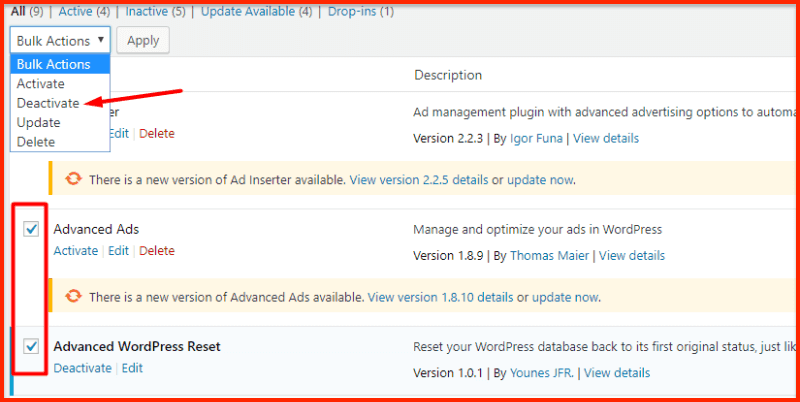
Now reactivate plugins one by one, so that you get a problem creating plugin.
Or you can not access your dashboard, then how to deactivate plugins:
When an internal server error occurs, most chances are that you can not access the dashboard. In this case, you have to take slightly different approach to deactivate plugins.
In this case, you have to resort to file manager or FTP. You can also use Filezilla.
Go to / wp-content / folder
Rename the plugins folder such as plugins_old.
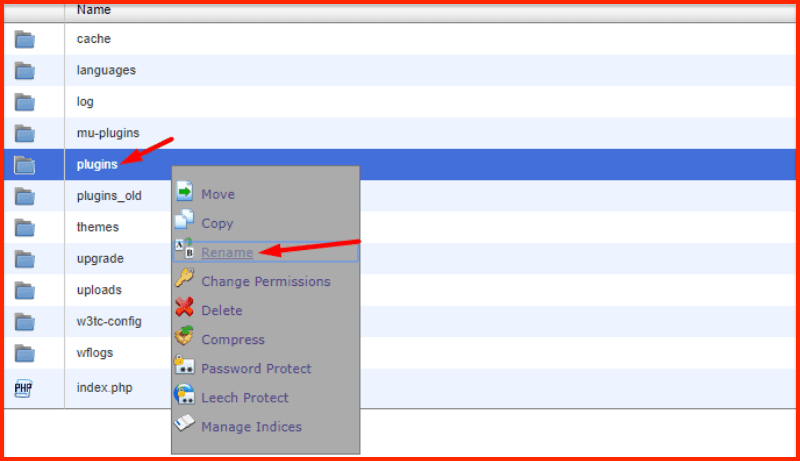
This will disable all plugins.
Now try to access your WordPress dashboard, if you are able to access it, you will be sure that the issue is with a plugin.
If you go to the plugin section of your dashboard, it will give you an error: "the plugin has been disabled due to an error; plugin file does not exist. "
Do not worry, we've discovered that the problem is with a plugin.
To reactivate plugins one by one:
Rename Plugin folder to plugins_old again in plugins only.
Now activate the plugins one by one from the WordPress dashboard one by one.
After activating every single plugin, browse to 3-4 pages of your blog. Keep doing this until you get an internal server error again. You will get a faulty plugin.
In most cases this will solve your problem.
Potential Fix 3: Increase your webhosting's PHP memory limit
If your problem still is not resolved then there are still some things you can do:
As you know, WordPress is a memory hobbing CMS, so when you install more plugins, or if you want more memory for WordPress, then in this case you need to increase the PHP memory limit, otherwise, error Will come
To do this, you have to edit the wp-config.php file. You can also access it from an FTP or file manager.
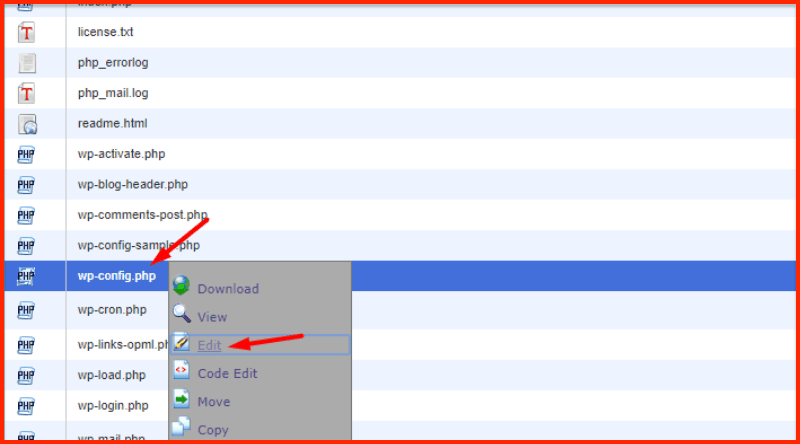
/ * That's all, stop editing! Happy blogging * You have to add this code before / message:
define( ‘WP_MEMORY_LIMIT’, ’64M’ );

This will only work if your host has not set memory limit for you less than this.
For this reason, if you do not get any change after editing this file, then you have to contact your host to increase the limit.
Potential Fix 4: Repeat WordPress Core Files
If nothing is the end, you will have to upload a clean copy of WordPress core files.
For this purpose, I recommend you to use FTP program instead of File Manager.
Download WordPress latest version from WordPress.org:
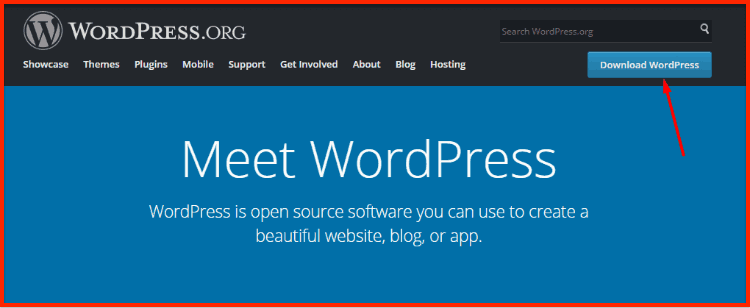
Once the download is finished, extract the ZIP file and delete it:
All wp-content folder
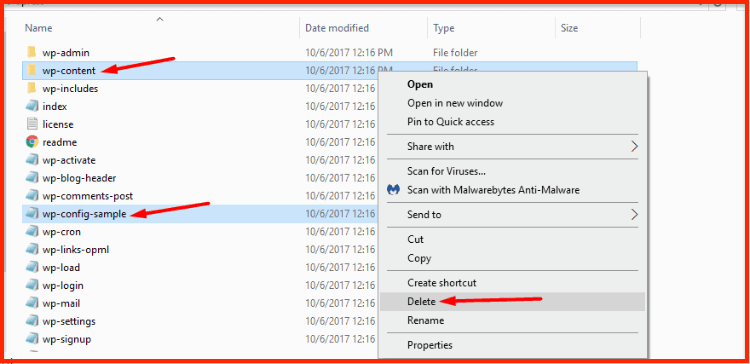
Error log in internal server error
If you do not know something specific from error people, then you:
You can contact your host's support to tell you exactly what the problem is.
Solve some of the straightforward common issues about which main you are telling below.
The hosts confirmed cPanel offers the following:
Bluehost
HostGator
SiteGround
Inmotion Hosting
How to fix "Internal Server Error" in WordPress?
Below are some of the most common ways to fix this error in WordPress. I recommend you go to the bottom and start from the top.
Potential Fix 1: Generate a New .htaccess file
.htaccess file is a file for the configuration of your web server. WordPress uses it to set the structure of your permalinks.
Because it controls the configuration of your web server, a small mistake in this file can also keep an internal server error in front of you.
But thankfully it is very easy to solve this problem. All you have to do is force WordPress to generate a new .htaccess file for you.
Learn how:
Step 1: Rename your existing .htaccess file
To begin, you have to rename your existing .htaccess file. You can do it in two ways:
Connect your site via FTP You can use Filezilla to do this.
You can also use cPanel's built in file manager tool.
I'm going to show you a process with file manager because it is simple for most users. But core principles remain the same, no matter what method you are using.
You can access the Final Manager from the cPanel dashboard:

Once you open File Manager, by going to your root directory, locate the .htaccess file.
Right click and select Rename.

Rename it to something like ".htaccess_old".
Now you have to generate a new .htaccess file to replace it.
Step 2: Generating new .htaccess file
To force your WordPress to generate a new .htaccess file, go to your WordPress Dashboard.
Then go to Settings → Permalinks.
You do not have to make any setting changes.
Just click the save changes button and WordPress will automatically generate a new file for you.

And just hopefully your site will start running again.
Potential Fix 2: By deactivating your plugins, find the faulty plugin.
If the .htaccess file was not your problem, then the next thing you can do is try to deactivate the plugins.
Generally plugin issues and conflicts can cause an internal server error. This often happens when you have installed a new plugin and immediately get an error in front of you.
By deactivating the plugins, you can delete the plugin that causes the problem.
If you still can access your WordPress dashboard, then how to deactivate your plugins:
If you still can access your dashboard, go to your plugin management area, then use the checkbox to deactivate all the plugins.

Now reactivate plugins one by one, so that you get a problem creating plugin.
Or you can not access your dashboard, then how to deactivate plugins:
When an internal server error occurs, most chances are that you can not access the dashboard. In this case, you have to take slightly different approach to deactivate plugins.
In this case, you have to resort to file manager or FTP. You can also use Filezilla.
Go to / wp-content / folder
Rename the plugins folder such as plugins_old.

This will disable all plugins.
Now try to access your WordPress dashboard, if you are able to access it, you will be sure that the issue is with a plugin.
If you go to the plugin section of your dashboard, it will give you an error: "the plugin has been disabled due to an error; plugin file does not exist. "
Do not worry, we've discovered that the problem is with a plugin.
To reactivate plugins one by one:
Rename Plugin folder to plugins_old again in plugins only.
Now activate the plugins one by one from the WordPress dashboard one by one.
After activating every single plugin, browse to 3-4 pages of your blog. Keep doing this until you get an internal server error again. You will get a faulty plugin.
In most cases this will solve your problem.
Potential Fix 3: Increase your webhosting's PHP memory limit
If your problem still is not resolved then there are still some things you can do:
As you know, WordPress is a memory hobbing CMS, so when you install more plugins, or if you want more memory for WordPress, then in this case you need to increase the PHP memory limit, otherwise, error Will come
To do this, you have to edit the wp-config.php file. You can also access it from an FTP or file manager.

/ * That's all, stop editing! Happy blogging * You have to add this code before / message:
define( ‘WP_MEMORY_LIMIT’, ’64M’ );

This will only work if your host has not set memory limit for you less than this.
For this reason, if you do not get any change after editing this file, then you have to contact your host to increase the limit.
Potential Fix 4: Repeat WordPress Core Files
If nothing is the end, you will have to upload a clean copy of WordPress core files.
For this purpose, I recommend you to use FTP program instead of File Manager.
Download WordPress latest version from WordPress.org:

Once the download is finished, extract the ZIP file and delete it:
All wp-content folder

After this, upload all the remaining files via FTP, on your WordPress site. Your FTP program will prompt you to duplicate files. When this happens, do not forget to select the option of Overwrite duplicate files.
Fixing Internal Server Error Message
At this point some solution might have worked for you so that your internal server error would have been solved.
If not, then main recommend you contact your host's support team. And if they can not help you, then you can hire a WordPress developer to fix things.
You can also comment, maybe we can solve your problem together!
Tell me if this error has happened to you and what did you do to solve it?
Be sure to share this article on social media so that more and more WordPress users help in solving errors.

Comments
Post a Comment